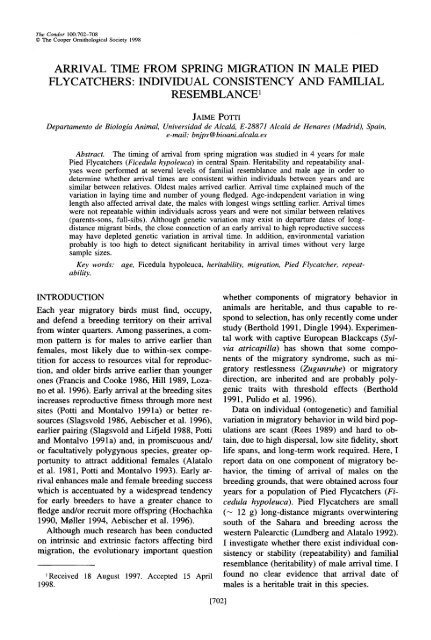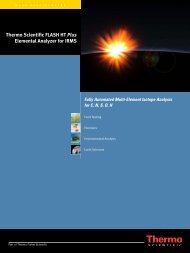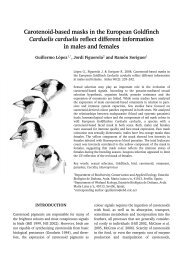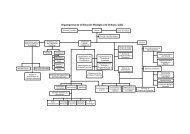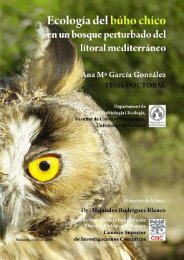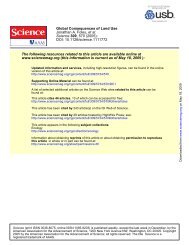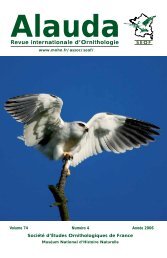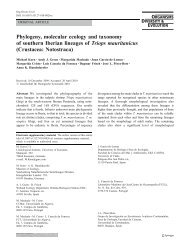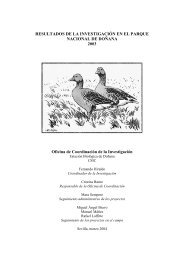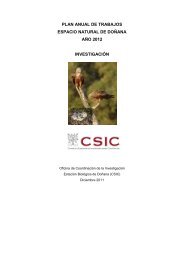Arrival Time from Spring Migration in Male Pied Flycatchers ...
Arrival Time from Spring Migration in Male Pied Flycatchers ...
Arrival Time from Spring Migration in Male Pied Flycatchers ...
You also want an ePaper? Increase the reach of your titles
YUMPU automatically turns print PDFs into web optimized ePapers that Google loves.
The Condor 100:702-708D The Cooper Ornithological Society 1998ARRIVAL TIME FROM SPRING MIGRATION IN MALE PIEDFLYCATCHERS: INDIVIDUAL CONSISTENCY AND FAMILIALRESEMBLANCE’JAIME POT-ITDepartamento de Biologia Animal, Universidad de Alcalri, E-28871 Alcalci de Henares (Madrid), Spa<strong>in</strong>,e-mail: bnjps@bioani.alcala.esAbstract. The tim<strong>in</strong>g of arrival <strong>from</strong> spr<strong>in</strong>g migration was studied <strong>in</strong> 4 years for male<strong>Pied</strong> <strong>Flycatchers</strong> (Ficedula hypoleuca) <strong>in</strong> central Spa<strong>in</strong>. Heritability and repeatability analyseswere performed at several levels of familial resemblance and male age <strong>in</strong> order todeterm<strong>in</strong>e whether arrival times are consistent with<strong>in</strong> <strong>in</strong>dividuals between years and aresimilar between relatives. Oldest males arrived earlier. <strong>Arrival</strong> time expla<strong>in</strong>ed much of thevariation <strong>in</strong> lay<strong>in</strong>g time and number of young fledged. Age-<strong>in</strong>dependent variation <strong>in</strong> w<strong>in</strong>glength also affected arrival date, the males with longest w<strong>in</strong>gs settl<strong>in</strong>g earlier. <strong>Arrival</strong> timeswere not repeatable with<strong>in</strong> <strong>in</strong>dividuals across years and were not similar between relatives(parents-sons, full-sibs). Although genetic variation may exist <strong>in</strong> departure dates of longdistancemigrant birds, the close connection of an early arrival to high reproductive successmay have depleted genetic variation <strong>in</strong> arrival time. In addition, environmental variationprobably is too high to detect significant heritability <strong>in</strong> arrival times without very largesample sizes.Key words: age, Ficedula hypoleuca, heritability, migration, <strong>Pied</strong> Flycatcher, repeatability.INTRODUCTIONEach year migratory birds must f<strong>in</strong>d, occupy,and defend a breed<strong>in</strong>g territory on their arrival<strong>from</strong> w<strong>in</strong>ter quarters. Among passer<strong>in</strong>es, a commonpattern is for males to arrive earlier thanfemales, most likely due to with<strong>in</strong>-sex competitionfor access to resources vital for reproduction,and older birds arrive earlier than youngerones (Francis and Cooke 1986, Hill 1989, Lozanoet al. 1996). Early arrival at the breed<strong>in</strong>g sites<strong>in</strong>creases reproductive fitness through more nestsites (Potti and Montalvo 1991a) or better resources(Slagsvold 1986, Aebischer et al. 1996),earlier pair<strong>in</strong>g (Slagsvold and Lifjeld 1988, Pottiand Montalvo 1991a) and, <strong>in</strong> promiscuous and/or facultatively polygynous species, greater opportunityto attract additional females (Alataloet al. 1981, Potti and Montalvo 1993). Early arrivalenhances male and female breed<strong>in</strong>g successwhich is accentuated by a widespread tendencyfor early breeders to have a greater chance tofledge and/or recruit more offspr<strong>in</strong>g (Hochachka1990, Meller 1994, Aebischer et al. 1996).Although much research has been conductedon <strong>in</strong>tr<strong>in</strong>sic and extr<strong>in</strong>sic factors affect<strong>in</strong>g birdmigration, the evolutionary important question‘Received1998.18 August 1997. Accepted 15 April17021whether components of migratory behavior <strong>in</strong>animals are heritable, and thus capable to respondto selection, has only recently come understudy (Berthold 1991, D<strong>in</strong>gle 1994). Experimentalwork with captive European Blackcaps (Sylviaatricapilla) has shown that some componentsof the migratory syndrome, such as migratoryrestlessness (Zugunruhe) or migratorydirection, are <strong>in</strong>herited and are probably polygenietraits with threshold effects (Berthold1991, Pulido et al. 1996).Data on <strong>in</strong>dividual (ontogenetic) and familialvariation <strong>in</strong> migratory behavior <strong>in</strong> wild bird populationsare scant (Rees 1989) and hard to obta<strong>in</strong>,due to high dispersal, low site fidelity, shortlife spans, and long-term work required. Here, Ireport data on one component of migratory behavior,the tim<strong>in</strong>g of arrival of males on thebreed<strong>in</strong>g grounds, that were obta<strong>in</strong>ed across fouryears for a population of <strong>Pied</strong> <strong>Flycatchers</strong> (Ficedzdahypoleuca). <strong>Pied</strong> <strong>Flycatchers</strong> are small(- 12 g) long-distance migrants overw<strong>in</strong>ter<strong>in</strong>gsouth of the Sahara and breed<strong>in</strong>g across thewestern Palearctic (Lundberg and Alatalo 1992).I <strong>in</strong>vestigate whether there exist <strong>in</strong>dividual consistencyor stability (repeatability) and familialresemblance (heritability) of male arrival time. Ifound no clear evidence that arrival date ofmales is a heritable trait <strong>in</strong> this species.
704 JAIME POTTI42681 45I<strong>Male</strong> age (years)FIGURE 1. <strong>Arrival</strong> times (means? SE) of male <strong>Pied</strong> <strong>Flycatchers</strong> <strong>in</strong> relation to age. Date 30 is April 30.Numbers above l<strong>in</strong>es are sample sizes. ’vanced with <strong>in</strong>creas<strong>in</strong>g age (Fig. I), althoughsignificant differences were apparent only betweenyearl<strong>in</strong>gs and older birds (Tukey a posterioritests). Standardized arrival times wereearlier for longer-w<strong>in</strong>ged males (I = -0.30, IZ= 164, P < O.OOl), which might be confoundedby age due to the significantly longer w<strong>in</strong>gs ofolder birds (Alatalo et al. 1984a). However, arrivaltime was earliest for males with longerw<strong>in</strong>gs even after controll<strong>in</strong>g for the effect of age(partial correlation, I = -0.21, P = 0.006). This<strong>in</strong>dicates that the effects of <strong>in</strong>creas<strong>in</strong>g age andw<strong>in</strong>g size on an earlier arrival date were at leastpartially <strong>in</strong>dependent.Be<strong>in</strong>g early was advantageous for male fitnessas the number of young fledged was lower formales that arrived later <strong>in</strong> the season (r = -0.38,n = 138, P < 0.001, Fig. 2). There was no cost<strong>in</strong> be<strong>in</strong>g too early, as <strong>in</strong>dicated by the nonsignificantquadratic regression term (quadratic coefficient= -0.002, P > 0.10; Fig. 2).In order to remove variation <strong>in</strong> arrival timesdue to age, I further standardized arrival timesfor familial comparisons by us<strong>in</strong>g the residualsof an ANOVA of standardized arrival time (seeMethods) <strong>in</strong> relation to male age (hereafter residualarrival times). Residual scores of arrivaltime were normally distributed (Kolmogorov-Smimov tests, P > 0.25) and their distributiondid not differ between young and older birds(Kolmogorov-Smirnov two-sample tests, P =0.22, n = 31 and 133 birds, respectively), norbetween presumptive fathers and sons with<strong>in</strong> thesubsample of familial data (P = 0.21, n = 22families).I obta<strong>in</strong>ed repeated records of arrival time for39 males, 32 of which had 2 records <strong>in</strong> different,usually successive years, 4 males had 3 annualrecords, and 3 males had 4 records. The repeatability(R) of arrival times was very low and notsignificant (R = 0.04; mean number of data per<strong>in</strong>dividual, no = 2.25, F38.87 = 1.10, P > 0.30).The same was true when standardized (R =0.08; Fx.8, = 1.19, P > 0.25) and residual arrivaltimes (R = 0.08; F38,87 = 1.21, P = 0.27;power > 0.10) were used. In order to removeany potential confound<strong>in</strong>g effects of variation <strong>in</strong>age and arrival time among males, I selected, forfurther confirmatory analysis, repeated recordsof arrival only for males 2 or more years old.The repeatability of residual arrival time <strong>in</strong> thisdata set was aga<strong>in</strong> nonsignificant (R = 0.09; no= 2.18, F26,58 = 1.22, P > 0.25), <strong>in</strong>dicat<strong>in</strong>g that<strong>in</strong>dividual adult males are not consistent <strong>in</strong> therelative tim<strong>in</strong>g of their arrivals on the breed<strong>in</strong>ggrounds as they age.There were 32 male sons <strong>in</strong> 22 families forwhich one or more arrival times of the sons andtheir presumptive male parents were known. Althoughthe relationship was positive, the heritabilityof residual arrival times did not differ significantly<strong>from</strong> zero (h* = 0.34 + 0.73, P >
HERITABILITY OF ARRIVAL DATE 7053-x2. . . .B p .. . . . . . y.. .. . .C= a, l-S.. . . . .p . . . . .CO5 -1 . I.: . . . . . .. .p -2 -.$j . . . .2 -3 -Zm5 -4 -..-20 -10 0 10 20 30Standardizedarrival dateFIGURE! 2. Relation between standardized date of arrival of male <strong>Pied</strong> <strong>Flycatchers</strong> and standardized numberof young fledged (see Methods for standardized computations). The l<strong>in</strong>e is the least-squares regression l<strong>in</strong>e(regression function: y = 0.11-0.05x).0.60, n = 22, Fig. 3). However, given the largevariances of arrival dates, the power of this testat the customary alpha level of 0.05 is very low(power = 0.07). Furthermore, that value of h* isentirely due to the “pull” of an outlier (Fig. 3);when this po<strong>in</strong>t is excluded a “no sense,” negativeheritability is obta<strong>in</strong>ed (h* = -0.50 + 1.00,P > 0.60, R = 21).There were 9 families for which the arrivaltimes of 2 or 3 (presumptive) full-sib males wereknown. The heritability of residual arrival datescalculated on the basis of (presumptive) full-sibresemblance was h* = 0.08 (no = 2.25, FS,,9 =1.09, P > 0.40).As there were more data available on lay<strong>in</strong>gdates, which are closely related to male arrivalI01ff = 0.34,SE = 0.73,P = 0.64 I2-I30z 0 01m 075 .! l-0 z2 I5 0-!n2oz0* ’-------------__i___________0 0q : 0-1 ’0I I,I0/-2 -1 0 1Residual arrival time of presumptive fatherFIGURE 3. Relationship between standardized arrival times of male <strong>Pied</strong> <strong>Flycatchers</strong> and their presumptivesons (see Methods for standardized computations). The l<strong>in</strong>e is the least-squares regression l<strong>in</strong>e (regressionfunction: y = 0.29 + 0.17x).
706 JAIME POTTIand pair<strong>in</strong>g dates (Potti and Montalvo 1991a), I<strong>in</strong>vestigated whether lay<strong>in</strong>g times for 142 maleswith 2-6 breed<strong>in</strong>g records were repeatable. Therepeatability was -0.00 (F,,,,,,, = 0.99, P >0.50) after standardiz<strong>in</strong>g the data set for significantvariation with respect to year and femaleand male ages by us<strong>in</strong>g residuals of a factorialANOVA. I also correlated the average residuallay<strong>in</strong>g dates <strong>in</strong> nests of sons with those of theirpresumptive male parents. The resemblance <strong>in</strong>lay<strong>in</strong>g date <strong>in</strong> nests of male parents and maleoffspr<strong>in</strong>g was nil (r = -0.01, it = 74, P > 0.90;power = 0.05) and the same was true when thecomparison was made with average residual lay<strong>in</strong>gdates of their mothers (controll<strong>in</strong>g for significantvariation of lay<strong>in</strong>g date with female age;I = -0.07, P > 0.70, IZ = 103 males <strong>in</strong> 71families; power = 0.06). Hence, there is no evidencethat arrival and lay<strong>in</strong>g times may be bothrepeatable or heritable <strong>in</strong> male <strong>Pied</strong> <strong>Flycatchers</strong>.However, the chances to correctly reject the nullhypothesis of no heritability of male arrival andlay<strong>in</strong>g dates were very low (power = 0.05-0.12).DISCUSSIONI have presented what to my knowledge are thefirst data obta<strong>in</strong>ed on familial resemblance <strong>in</strong>tim<strong>in</strong>g of arrival to the breed<strong>in</strong>g sites <strong>in</strong> a longdistancemigrant passer<strong>in</strong>e. The estimates werenot confounded by the social environment (Rees1989) because <strong>Pied</strong> <strong>Flycatchers</strong> live solitarylives after they become <strong>in</strong>dependent of their parents,and they migrate alone (Lundberg and Alatalo1992). Us<strong>in</strong>g a large data set, Rees (1989)showed that arrival and departure times of w<strong>in</strong>ter<strong>in</strong>gsocial Bewick’s Swans (Cygnus columbi-U~US [bewickii]) had a slight heritability (h* =0.10-o. 19), although <strong>in</strong> this case the estimatecould to some degree be confounded by the socialhabits of swans and their tendency to migrate<strong>in</strong> groups, hence cultural, not genetic transmission.This problem did not exist <strong>in</strong> my study,and I still was unable to f<strong>in</strong>d evidence for geneticvariation <strong>in</strong> the arrival times <strong>from</strong> spr<strong>in</strong>gmigration <strong>in</strong> male <strong>Pied</strong> <strong>Flycatchers</strong>.One may argue that lack of father-son resemblance<strong>in</strong> arrival dates may be due to geneticanalyses be<strong>in</strong>g plagued by a high frequency ofextra-pair fertilizations (EPF), which are knownto occur <strong>in</strong> the <strong>Pied</strong> Flycatcher at variable rates(Lifjeld et al. 1991, Gelter and Tegelstriim1992). No DNA f<strong>in</strong>gerpr<strong>in</strong>t<strong>in</strong>g estimates of ge-netic parentage are available for my populationand, unfortunately, the method to compute EPFrates on the basis of differences <strong>in</strong> heritabilityestimates of morphological traits us<strong>in</strong>g motherandfather-on-offspr<strong>in</strong>g regressions (Alatalo etal. 1984a) has proven unreliable to that end(Hasselquist et al. 1994, Potti and Mer<strong>in</strong>o 1994).However, misassigned parentage is not a problemfor repeatability estimates, which <strong>in</strong>dicatedan overall <strong>in</strong>constancy of male arrival and lay<strong>in</strong>gdates, and hence a likely absence of detectablegenetic variation (Boake 1989). Check<strong>in</strong>g forthe existence of repeatability is a first step <strong>in</strong>proposed protocols to detect genetic variationbecause repeatability sets an upper limit to theheritability of a trait, which cannot be larger thanthe former (Falconer 1986, Boag and vanNoordwijk 1987). In addition, because geneticvariation with<strong>in</strong> <strong>in</strong>dividuals is absent, EPFs arenot a confound<strong>in</strong>g factor <strong>in</strong> the computations ofrepeatability, although they certa<strong>in</strong>ly are a problemfor the quantification of heritability. In spiteof this, the consistency of nonsignificant repeatabilityand heritability estimates <strong>in</strong> this study <strong>in</strong>dicatesthat, whatever may be the rate of EPFs<strong>in</strong> my population, genetic variation for arrivaltime, if present, must be low.There are, however, further reasons to be cautiousabout the absence of genetic variation, becauseit may exist but be masked by genotypeenvironment<strong>in</strong>teractions, which are likely to bepresent <strong>in</strong> such a complex “trait” as arrival date.<strong>Arrival</strong> times must depend to some degree ondistances migrated and departure dates <strong>from</strong>w<strong>in</strong>ter quarters, which <strong>in</strong> turn depend upon environmentalvariables, <strong>in</strong>clud<strong>in</strong>g photoperiodand weather conditions there. In addition, thepredictably high environmental variation met bythe birds while on passage <strong>in</strong> their migratoryjourney, and the likely important roles played <strong>in</strong>migration performance by bird age and previousexperience with both the migration route and thearea (Montalvo and Potti 1992, Cantos and Tellerfa1994), may sum up to a high stochasticvariance <strong>in</strong> tim<strong>in</strong>g of arrival (Aebischer et al.1996). Body condition (Arvidsson and Neergard1991), <strong>in</strong>clud<strong>in</strong>g lack of <strong>in</strong>fection by hematozoanparasites (Ratti et al. 1993), and body size(w<strong>in</strong>g and first primary lengths; Alatalo et al1984b, Potti and Montalvo 1991a) also are relatedto early arrival <strong>in</strong> at least some bird species.For <strong>in</strong>stance, male flycatchers with the longestw<strong>in</strong>gs arrived earlier <strong>in</strong>dependently of their
HERITABILITY OF ARRIVAL DATE 707age, which may be <strong>in</strong>terpreted as evidence thata size constra<strong>in</strong>t may operate on migration speedand counters the argument that late arrivals byyoung, small-w<strong>in</strong>ged birds are due to their relative<strong>in</strong>experience with the migratory journey.An analytical problem <strong>in</strong> this study was thelow power of statistical tests to detect significantheritability (Falconer 1986, Arnold 1994). Powercalculations <strong>in</strong>dicate that very large samplesizes are necessary to detect a low heritabilitywith the sample variance observed. For example,to detect a low heritability of, say, 0.10 (regressionslope = 0.05) with a reasonably high(Thomas and Juanes 1996) power of 0.80 (thatis, an 80% chance of gett<strong>in</strong>g a significant resultgiven that the null hypothesis of no heritabilityis false), it would be necessary to have data onarrival dates for 641 families, imply<strong>in</strong>g about 32years of data collection at the current recruitmentrate <strong>in</strong> my population (Potti and Montalvo1991b). If heritability of arrival date was larger,say 0.50 (a common heritability for morphologicaltraits, Boag and van Noordwijk 1987), then335 father-son pairs (about 17 years of fieldwork) would have to be sampled to detect it atalpha = 0.05 and power = 0.80. Similar computationsfor detect<strong>in</strong>g a low (h2 = 0.10) heritabilityof “male lay<strong>in</strong>g dates” result <strong>in</strong> unwieldlyfigures (> 13,000 and > 295,000 datapairs, us<strong>in</strong>g lay<strong>in</strong>g dates of mother and father<strong>Pied</strong> <strong>Flycatchers</strong>, respectively).The fact that male arrival time <strong>in</strong> spr<strong>in</strong>g isclosely connected to male fitness <strong>in</strong> the <strong>Pied</strong> Flycatcher(Fig. 2) might be taken as a priori evidence<strong>in</strong> support of a predictable absence of geneticvariation <strong>in</strong> this characteristic. Geneticvariance might have been depleted by the closeassociation of early breed<strong>in</strong>g to fitness due tostrong and constant selection, with all rema<strong>in</strong><strong>in</strong>gvariation be<strong>in</strong>g enviromentally caused (“Fisher’sfundamental theorem;” Mousseau and Roff1987). The evidence presented here and background<strong>in</strong>formation on this population are consistentwith this <strong>in</strong>terpretation. An early date ofbreed<strong>in</strong>g is the most important determ<strong>in</strong>ant ofrecruitment <strong>in</strong> this population (Potti and Montalvo1991b; unpubl. data), impos<strong>in</strong>g a strongselection pressure to settle and breed early. Alternatively,as discussed above, low heritabilityof arrival date may be due to the predom<strong>in</strong>antimportance of environmental variables affect<strong>in</strong>git (Price and Schluter 1991), i.e., arrival timesmay be subject to all the variation <strong>in</strong> the traitsthat affect it plus additional environmental variation,such that a low heritability is to be expected(Price and Schluter 1991). For <strong>in</strong>stance,w<strong>in</strong>g length seems to reta<strong>in</strong> genetic variance <strong>in</strong>this population (around 0.50; unpubl. data),whereas correspond<strong>in</strong>g variation <strong>in</strong> arrival time,one of its correlates, is almost undetectable. Thisillustrates that the l<strong>in</strong>k <strong>from</strong> genes to w<strong>in</strong>glength to a life-history trait such as arrival dateis long: much environmental variance is addedat each step <strong>in</strong> the path of morphological to lifehistorytraits, so that even though there may bea genetic component to arrival date via its connectionwith heritable body traits, this must bevery small (Price and Schluter 1991, Roff 1997).It is not possible to dist<strong>in</strong>guish between the “exhaustionof genetic variance hypothesis” and the“environmental noise hypothesis” with the dataat hand and, most likely, both may be true.Genetic variation may underlie the proximatecontrol of departure dates <strong>in</strong> long-distance migrants,as well as <strong>in</strong> birds migrat<strong>in</strong>g shorter distances(Berthold 1991), but still be undetectablewith arrival times to the breed<strong>in</strong>g grounds. Individualsmay not be consistent <strong>in</strong> their time ofarrival <strong>from</strong> one year to another because complex<strong>in</strong>teractions between environmental factorsaffect<strong>in</strong>g arrival date and migration performance.Demonstrat<strong>in</strong>g among-population geneticvariation <strong>in</strong> major traits, such as c&annualrhythms (Berthold 1991, Pulido et al. 1996), canhelp to expla<strong>in</strong> with<strong>in</strong>- and between-speciesvariation <strong>in</strong> the urge to migrate and hence ondeparture dates to breed<strong>in</strong>g or w<strong>in</strong>ter<strong>in</strong>g areas(Ellegren 1990). However, environmental variationwill likely make it difficult to demonstratewith<strong>in</strong>-population genetic variation <strong>in</strong> arrivaltimes of migrant birds <strong>in</strong> natural sett<strong>in</strong>gs.ACKNOWLEDGMENTSI thank the reviewers for detailed comments improv<strong>in</strong>ga first draft. The study was funded by grants of theSpanish Direccidn General de Investigaci6n Cientificay Ttcnica (projects PB86-0006-C02-02 and PB91-0084-CO3-03). Dur<strong>in</strong>g preparation of the manuscript Iwas supported by project PB94-0070-C02-02.LITERATURECITEDAEBISCHER, A., N. PERRIN, M. Kamo, _I. STULIER, AND D.R. MEYER. 1996. The role of territory choice, matechoice and arrival dam on breed<strong>in</strong>g success <strong>in</strong> theSavi’s Warbler Locustella lusc<strong>in</strong>ioides. J. Avian Biol.27:143-152.ALATALO, R.V., A. CARLSON, A. LUNDBERG, AND S.ULFsm.4m.1981. The conflict between male polygamy
708 JAIME PO-IT-1and female monogamy: the case of the <strong>Pied</strong> FlycatcherFicedzda hypoleuca. Am. Nat. 117:738-753.catchers revealed by DNA f<strong>in</strong>gerpr<strong>in</strong>t<strong>in</strong>g. Behav.Ecol. Sociobiol. 29:95-101.ALATALO, R. V., L. ~JSTAFSSON, AND A. LUNDBERG L~Z.ANO, G. A., S. PERREAULT, AND R. E. &ON. 1996.1984a. High freouencv of cuckoldrv <strong>in</strong> <strong>Pied</strong> andCollared I&atchers. dikes 42:41-4?.Age, arrival date and reproductive success of maleAmerican Redstarts Setouhapa ruticilla. J. AvianALATALO, R. V., L. GUSTAFSSON, AND A. LUNDBERG. Biol. 27:16&170. - -198413. Why do young passer<strong>in</strong>es have shorterw<strong>in</strong>gs than older birds? Ibis 126:410-415.ARNOLD, S. J. 1994. Multivariate <strong>in</strong>heritance and evolution:a review of concepts, p. 17-48. In C. R. B.Boake [ed.], Quantitative genetic studies of behavioralevolution. Univ. Chicago Press, Chicago, IL.LUNDBERG, A., AND R. V. AL_ATALO. 1992. The <strong>Pied</strong> Flycatcher.T & A. D. Poyser, London.MILLER, A. P 1994. Phenotype-dependent arrival timeand its consequences <strong>in</strong> a migratory bird. Behav.Ecol. Sociobiol. 35:115-122.MONTALVO, S., AND J. Porrt. 1992. Breed<strong>in</strong>g dispersalhvIDSSON, B. L., AND R. NFERGARLX 1991. Mate choice <strong>in</strong> Spanish <strong>Pied</strong> <strong>Flycatchers</strong> Ficedula hypoleuca. Or<strong>in</strong>the Willow Warbler-a field experiment. Behav.Ecol. Sociobiol. 29:225-229.BEXTHOLD, l? 1991. Genetic control of migratory behaviour<strong>in</strong> birds. Trends Ecol. Evol. 6:254-257.BOAG, l? T, AND A. J. VAN N~~RDWUK. 1987. Quamitativegenetics, p. 45-78. In E Cooke and F! A.Buckley [eds.], Avian genetics. Academic Press,London.BOAKE, C. R. B. 1989. Repeatability: its role <strong>in</strong> evolutionarystudies of mat<strong>in</strong>g behavior. Evol. Ecol. 3:173-182.CANTOS, E J., AND J. L. TELLERS. 1994. Stopover sitefidelity of four migrant warblers <strong>in</strong> the lberian pen<strong>in</strong>sula.J. Avian Biol. 25: 131-134.DINGLE, H. 1994. Genetic analyses of animal migration.p. 145-164. In C. R. B. Boake, [ed.], Quantitativegenetic studies of behavioral evolution. Univ. ChicagoPress, Chicago.DUPONT, W. D., AND W. D. PLUMMER JR. 1990. Powernis Stand. 23:491-498.MOUSSEAU, T A., AND D. A. Row. 1987. Natural selectionand the heritability of fitness components. Heredity59:181-197.PATTI, J., AND S. MERINO. 1994. Heritability estimatesand maternal effects on tarsus length <strong>in</strong> <strong>Pied</strong> <strong>Flycatchers</strong>,Ficedula hypoleuca. Gecologia 100:33 l-338.Porn, J., AND S. MEIUNO. 1995. Some male <strong>Pied</strong> <strong>Flycatchers</strong>Ficedula hypoleucu <strong>in</strong> Iberia become cdllaredwith age. Ibis 137:405-409.Porn, J., AND S~MONTALVO. 1991a. <strong>Male</strong> arrival andfemale mate choice <strong>in</strong> <strong>Pied</strong> <strong>Flycatchers</strong> Ficedula hypoleuca<strong>in</strong> central Spa<strong>in</strong>. Grnis Stand. 22:45-54.Porn, J., AND S. MONTALVO. 1991b. Return rate, age atfirst breed<strong>in</strong>g and natal dispersal of <strong>Pied</strong> <strong>Flycatchers</strong>Ficedula hypoleuca <strong>in</strong> central Spa<strong>in</strong>. Ardea 79:419-428.Porn J., AM) S. MONTALVO. 1993. Polygyny <strong>in</strong> Spanishand sample size calculations: a review and computer <strong>Pied</strong> Flvcatchers Ficedula hvooleuca. ,* Bird Studv . 40:program. Controlled Cl<strong>in</strong>ical Trials 11: 116-128.31-37:ELLEGREN, H. 1990. Tim<strong>in</strong>g of autumn migration <strong>in</strong>Bluethroats Zaw<strong>in</strong>ia s. svecica depends on tim<strong>in</strong>g ofbreed<strong>in</strong>g. Chnis Fennica 67:13-17.FALCONER D S. 1986. Introduction a la genetica cuantitativa.Cecsa Mexico D.E. Mexico.FRANCIS, C. M., AND E COOKE. 1986. Differential tim<strong>in</strong>gof spr<strong>in</strong>g migration <strong>in</strong> wood warblers. Auk 103:548-556.GELTER, H. l?, AM) H. TEGELSTR~M. 1992. High hequencyof extra-pair paternity <strong>in</strong> Swedish pied flycatchersrevealed by allozyme electrophoresis andDNA f<strong>in</strong>gerpr<strong>in</strong>t<strong>in</strong>g. Behav. Ecol. Sociobiol. 31: 1-7.GWINNER, E. 1977. Circannual rhythms <strong>in</strong> bird migration.Annu. Rev. Ecol. Syst. 8:381-405.HASSELQUIST, D., S. BENSCH, AND T VON SCHAN~Z. 1994.Estimat<strong>in</strong>g cuckoldry <strong>in</strong> birds: the heritability methodand DNA f<strong>in</strong>gerpr<strong>in</strong>t<strong>in</strong>g give different results. Oikos72:173-178.HILL, G. E. 1989. Late spr<strong>in</strong>g arrival and dull nuptialplumage: aggression avoidance by yearl<strong>in</strong>g males?Anim. Behav. 37665-673.HOCHACHKA, W. 1990. Seasonal decl<strong>in</strong>e <strong>in</strong> reproductiveperformance of Song Sparrows. Ecology 71: 1279-1288.KARLSSON L., K. F%RSSON, AND G. WALIN~ER. 1986.Age<strong>in</strong>g and sex<strong>in</strong>g <strong>in</strong> <strong>Pied</strong> <strong>Flycatchers</strong> Ficedula hypoleuca.Var Fagelvaild 45:131-146.LIFJELo, J. T, T SLAGSVOLD, AND H. M. LAMPE. 1991.Low frequency of extra-pair paternity <strong>in</strong> pied fly-PRICE, T, AND D. SCHLUTER. 1991. On the low heritabilityof life-history traits. Evolution 45:853-861.Pu~mo, E, I? BERTHOLD, AND A. J. VAN NOORDWUK. 1996.Frequency of migrants and migratory activity are geneticallycorrelated <strong>in</strong> a bird population: evolutionaryimplications. Proc. Natl. Acad. Sci. 93: 14642-14647.R0r1, O., R. DUFVA, AND R. V. ALATALO. 1993. Bloodparasites and male fitness <strong>in</strong> the <strong>Pied</strong> Flycatcher.Oecologia 96:410-414.REES, E. C. 1989. Consistency <strong>in</strong> the tim<strong>in</strong>g of migrationfor <strong>in</strong>dividual Bewick’s Swans. Anim. Behav. 38:384-393.ROFF, D. A. 1997. Evolutionary quantitative genetics.Chauman and Hall, New York.SLAGSVOL~, T 1986. Nest settlement by the <strong>Pied</strong> Flycatcher.Does the female choose her mate for thequality of his house or himself! Gmis Stand. 17:210-220.SLAGSVOID, T., AND J. T L~;JELD. 1988. Plumage colourand sexual selection <strong>in</strong> the <strong>Pied</strong> Flycatcher Ficeduluhypoleuca. Anim. Behav. 36:395-407.S~ENSSON, L. 1992. Identification guide to European passer<strong>in</strong>es.Svensson, Stockholm.THOMAS, L., AND E JUANES. 1996. The importance ofstatistical power analysis: an example <strong>from</strong> AnimalBehaviour. Anim. Behav. 52:856859.ZAR, J. H. 1996. Biostatistical analysis. 3rd ed. PrenticeHall, Englewood Cliffs, NJ.


